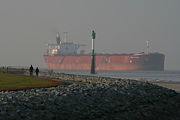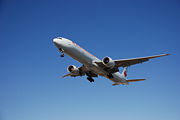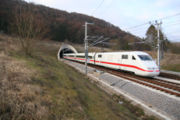Transport
2008/9 Schools Wikipedia Selection. Related subjects: Engineering
Transport or transportation is the movement of people and goods from one place to another. The term is derived from the Latin trans ("across") and portare ("to carry"). Industries which have the business of providing transport equipment, transport services or transport are important in most national economies, and are referred to as transport industries.
The field can be divided into infrastructure, vehicles, and operations. Infrastructure consists of the fixed installations necessary for transport, and may be roads, railways, airways, waterways, canals and pipelines or terminals such as airports, railway stations, bus stations and seaports. Vehicles traveling on the network include automobiles, bicycles, buses, trains, people and aircraft. Operations deal with the way the vehicles are operated, and the procedures set for this purpose including the financing, legalities and policies.
Mode
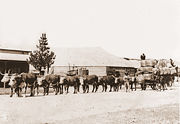
Human-powered
Human-powered transport is the transport of person(s) and/or goods using human muscle power. Like animal-powered transport, human-powered transport has existed since time immemorial in the form of walking, running and swimming. Modern technology has allowed machines to enhance human-power. Many forms of human-powered transport remain popular for reasons of lower cost, leisure, physical exercise and environmentalism. Human-powered transport is sometimes the only type available (especially in underdeveloped or inaccessible regions), and is considered an ideal form of sustainable transportation.
Although humans are able to walk without infrastructure, the transport can be enhanced through the use of roads, especially when enforcing the human power with vehicles, such as bicycles and inline skates. Human-powered vehicles have also been developed for highly encumbering environments,¸such as snow and water, by watercraft rowings and skiing; even the air can be entered with human-powered aircraft.
Animal-powered
Animal-powered transport is the use of working animals (also known as "beasts of burden") for the movement of people and goods. Humans may ride some of the animals directly, use them as pack animals for carrying goods, or harness them, singly or in teams, to pull (or haul) sleds or wheeled vehicles. Animals are superior to people in their speed, endurance and carrying capacity; prior to the Industrial Revolution they were used for all land transport impracticable for people, and they remain an important mode of transport in less developed areas of the world.
Air
A fixed-wing aircraft, commonly called airplane or aeroplane, is a heavier-than-air craft where movement of the wings in relation to the aircraft is not used to generate lift. The term is used to distinguish from rotary-wing aircraft, where the movement of the lift surfaces relative to the aircraft generates lift. A heliplane is both fixed-wing and rotary-wing. Fixed-wing aircraft range from small trainers and recreational aircraft to large airliners and military cargo aircraft.
Two necessities for aircraft are air flow over the wings for lift, and an area for landing. The majority of aircraft also need an airport with the infrastructure to receive maintenance, restocking, refueling and for the loading and unloading of crew, cargo and passengers. While the vast majority of aircraft land and take off on land, some are capable of take off and landing on ice, snow and calm water.
The aircraft is the second fastest method of transport, after the rocket. Commercial jets can reach up to 875 km/h, single-engine aircraft 175 km/h while the speedrecond is held by the SR-71 with a speed of 3,529.56 km/h (2193.17 mph, 1905.81 knots). Aviation is able to quickly transport people and limited amounts of cargo over longer distances, but incur high costs and energy use; for short distances or in unaccessible places helicopters can be used.
Pipeline

Pipeline transport sends goods through a pipe, most commonly liquid and gases are sent, but pneumatic tubes can send solid capsules using compressed air. Any chemically stable liquid or gas can be sent through a pipeline; sewage, slurry, water and even beer pipelines exist,while long-distance networks are used for petroleum and natural gas. The idea was launched in 1863
Rail
Rail transport is the transport of passengers and goods along railways (or railroads), consisting of two parallel steel rails, generally anchored perpendicular to beams (termed sleepers or ties) of timber, concrete or steel to maintain a consistent distance apart, or gauge. The rails and perpendicular beams are usually then placed on a foundation made of concrete or compressed earth and gravel in a bed of ballast to prevent the track from buckling (bending out of its original configuration) as the ground settles over time beneath and under the weight of the vehicles passing above. The vehicles traveling on the rails are arranged in a train; a series of individual powered or unpowered vehicles linked together, displaying markers. These vehicles (referred to, in general, as cars, carriages or wagons) move with much less friction than on rubber tires on a paved road, and the locomotive that pulls the train tends to use energy far more efficiently as a result.
A train consists of rail vehicles that move along guides to transport freight or passengers from one place to another. The guideway ( permanent way) usually consists of conventional rail tracks, but might also be monorail or maglev. Propulsion for the train is provided by a separate locomotive, or from individual motors in self-propelled multiple units. Most trains are powered by diesel engines or by electricity supplied by trackside systems, but other sources of power such as steam engine, horses, wire, gravity, pneumatics, or gas turbines are possible.
Stone railways were constructed by the Greeks in the 6th century BC, while the first iron rails were laid in 1768 with the steam engine introduced in 1804. A critical part of industrialization, tracks were soon laid throughout the world. By the end of the century electric traction evolved, supplemented by diesel in the next. High-speed rail was introduced by Shinkansen in 1964. Rail transport remains the most energy efficient land transport, and used for long-distance freight and all distances of passenger transport. In cities rapid transit and trams are common parts of public transport.
Road
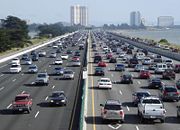
A road is an identifiable route, way or path between two or more places. Roads are typically smoothed, paved, or otherwise prepared to allow easy travel; though they need not be, and historically many roads were simply recognizable routes without any formal construction or maintenance. In urban areas roads may pass through a city or village and be named as streets, serving a dual function as urban space easement and route.
The most common road vehicle is the automobile; a wheeled passenger vehicle that carries its own motor. Other users of roads include buses, trucks, motorcycles, bicycles and pedestrians. As of 2002 there were 590 million automobiles worldwide.
The first forms of road transport were horses, oxen or even humans carrying goods over dirt tracks that often followed game trails. The Roman Empire was in need for armies to be able to travel quickly; they built deep roadbeds of crushed stone as an underlying layer to ensure that they kept dry, as the water would flow out from the crushed stone, instead of becoming mud in clay soils. John Loudon McAdam designed the first modern highways of inexpensive paving material of soil and stone aggregate known as macadam during the Industrial Revolution. Coating of cobblestones and wooden paving were popular during the 19th century while tarmac and concrete paving became popular during the 20th.
Automobiles offer high flexibility and with low capacity, but are deemed with high energy and area use, and the main source of noise and air pollution in cities; buses allow for more efficient travel at the cost of reduced flexibility. Road transport by truck is often the initial and final stage of freight transport.
Water

Ship transport is the process of transport by barge, boat, ship or sailboat over a sea, ocean, lake, canal or river. A watercraft is a vehicle designed to float on and move across (or under) water. The need for buoyancy unites watercraft, and makes the hull a dominant aspect of its construction, maintenance and appearance.
The first craft were probably types of canoes cut out from tree trunks. The colonization of Australia by Indigenous Australians provides indirect but conclusive evidence for the latest date for the invention of ocean-going craft. Early sea transport was accomplished with ships that were either rowed or used the wind for propulsion, or a combination of the two. other solutions include horse-powered boats, with horses on the deck providing power.
In the 1800s the first steam ships were developed, using a steam engine to drive a paddle wheel or propeller to move the ship. The steam was produced using wood or coal. Now most ships have an engine using a slightly refined type of petroleum called bunker fuel. Some specialized ships, such as submarines, use nuclear power to produce the steam. Recreational or educational craft still use wind power, while some smaller craft use internal combustion engines to drive one or more propellers, or in the case of jet boats, an inboard water jet. In shallow draft areas hovercraft are propelled by large pusher-prop fans.
Although slow, modern sea transport is a highly effective method of transporting large quantities of non-perishable goods. Transport by water is significantly less costly than air transport for trans-continental shipping.
Intermodal transport
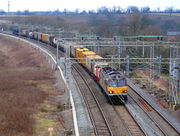
Intermodal freight transport is the combination of multiple modes of transportation for a single shipment; containers allow seamless integration of sea, rail and road transport and have reduced transshipment costs.
Intermodal passenger transport is where a journey is performed through the use of several modes of transport; since all human transport normally starts and ends with walking, all passenger transport can be considered intermodal. Public transport may also involve the intermediate change of vehicle, within or across modes, at at transport hub, such as a bus- or railway station.
Impact
Transport is a key necessity for specialization—allowing production and consumption of product to occur at different locations. Transport has throughout history been the gate to expansion; better transport allows more trade and spread of people. Economic growth has always been dependent on increased capacity and more rational transport. But the infrastructure and operation of transport incurs large impact on the land and is the largest drainer of energy, and transport sustainability has become a major issue.
Modern society dictates a physical distinction between home and work, forcing people to transport themselves to place of work or study, supplemented by the need to temporarily relocate for other daily activities. Passenger transport is also the essence tourism, a mayor part of recreational transport. Commerce needs transport of people to conduct business, either to allow face-to-face communication for important decisions, or to transport specialists from their regular place of work to sites where they are needed.
Planning
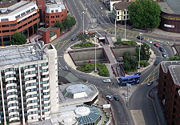
Transport planning allows for high utilization and less impact regarding new infrastructure. Using models of transport forecasting, planners are able to predict future transport patters. On the operative level, logistics allows owners of cargo to plan transport as part of the supply chain. Transport as a field is studied through transport economics, the backbone for the creation of regulation policy by authorities.
Transport engineering, a sub-discipline of civil engineering, and must take into account trip generation, trip distribution, mode choice and route assignment, while the operative level is handles through traffic engineering.
Because of the negative impacts made, transport often becomes the subject of controversy related to choice of mode, as well as increased capacity. Automotive transport can be seen as a tragedy of the commons, where the flexibility and comfort for the individual deteriorate the natural and urban environment for all. Density of development depends on mode of transport, with public transport allowing for better spacial utilization. Good land use keeps common activities close to peoples homes and places higher-density development closer to transport lines and hubs; minimize the need for transport. There are economies of agglomeration. Beyond transportation some land uses are more efficient when clustered. Transportation facilities consume land, and in cities, pavement (devoted to streets and parking) can easily exceed 20 percent of the total land use. An efficient transport system can reduce land waste.
Too much infrastructure and too much smoothing for maximum vehicle throughput means that in many cities there is too much traffic and many—if not all—of the negative impacts that come with it. It is only in recent years that traditional practices have started to be questioned in many places, and as a result of new types of analysis which bring in a much broader range of skills than those traditionally relied on—spanning such areas as environmental impact analysis, public health, sociologists as well as economists who increasingly are questioning the viability of the old mobility solutions. European cities are leading this transition.
Construction
The financing of infrastructure can either be public or private; since it often is a natural monopoly and a necessity for the public, roads, and in some countries railways and airports are funded through taxation. New infrastructure projects can involve large spendings, and encompass many megaprojects.
Operations may be public, but airlines and road transport is commonly private, with the typical exception of mass transit. Shipping remains a highly competitive industry with little regulation, but ports can be public owned.
Environment
Transport is a major use of energy, burning most of the world's petroleum; creating air pollution, including nitrous oxides and particulates and being a significant contributor to global warming through emission of carbon dioxide—the fastest growing emission sector. Environmental regulations in developed countries have reduced the individual vehicles emission; this has been offset by an increase in the number of vehicles and more use of each vehicle. Energy use and emissions vary largely between modes, causing |environmentalists to call for a transition from air and road to rail, sea and human-powered transport. Other environmental impacts of transport systems include traffic congestion and automobile-oriented urban sprawl, which can consume natural habitat and agricultural lands.

